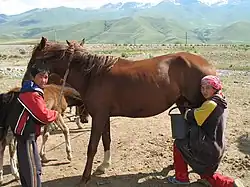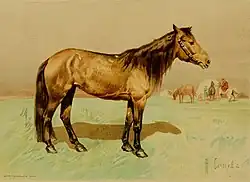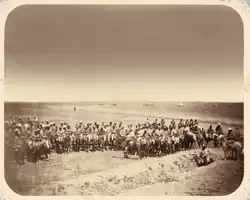Kyrgyz Horse
 A mare being milked in Suusamyr, Kyrgyzstan | |
| Conservation status | FAO (2007): not at risk[1]: 81 |
|---|---|
| Other names | |
| Country of origin | Kyrgyz Republic |
| Distribution | nation-wide |
| Use | |
| Traits | |
| Height |
|
| Colour | dark colours grey |
| Breed standards | |


The Kyrgyz Horse or Kirgiz Horse is a traditional breed of small horse from the Kyrgyz Republic (Kyrgyzstan).[2] Kyrgyz people associate it with their nomadic past.[4]: 12 During the Soviet era of Kyrgyz history, the Kyrgyz Horse was cross-bred with imported foreign breeds, including Don and Thoroughbred strains, to create a new and larger breed, the Novokirgiz or New Kirgiz.[3]: 489
History
In the late nineteenth century there were some two million Kyrgyz horses in the area that is now Kyrgyzstan.[5] During the Soviet era, the traditional Kyrgyz horse was cross-bred with larger but weaker imported foreign breeds, including Don and Thoroughbred strains, to create a new breed, the Novokirgiz or New Kirgiz.[3]: 489 [5] Numbers of the traditional native breed were greatly reduced,[5] but have since shown some recovery.[6] The population of the Kyrgyz breed was last reported to DAD-IS in 2002, when the total population was 78 300 head.[2] In 2007 its conservation status was recorded by the FAO as "not at risk".[1]: 74
An association for the protection of the Kyrgyz Horse, the Fondation Kyrgyz Ate, was set up in Bishkek in the early twenty-first century. A breed standard was drawn up, based partly on a description found in archives in Saint Petersburg, and was approved by the national ministry of agriculture.[4]: 14
Characteristics
The Kyrgyz Horse is a small mountain horse. It is sure-footed and agile, with the necessary stamina and endurance for the mountain environment.[4]: 14 [7] The coat may be dark or grey.[3]: 480
Use
The Kyrgyz Horse is used as a riding horse, for horse-racing, and as a light harness horse. It is important for production of meat and milk.[3]: 480 Horsemeat production in Kyrgyzstan in 2002 was 24 800 tonnes, about one eighth of the total meat produced in that year.[8]: 14 The mare's milk is often fermented to make kumis.[4]: 14
With traditional mounted games such as kok-boru (also known in Kyrgyzstan as ulak-tartysh), oodarysh (mounted wrestling) and kyz-kuumai (meaning roughly "chase the girl"), the Kyrgyz Horse may be perceived as a symbol of the pre-Soviet nomadic past of Kyrgyz people, and thus as an element of post-Soviet Kyrgyz culture and national identity.[4]: 14 [5][6]
See also
References
- ^ a b Barbara Rischkowsky, Dafydd Pilling (editors) (2007). List of breeds documented in the Global Databank for Animal Genetic Resources, annex to: The State of the World's Animal Genetic Resources for Food and Agriculture. Rome: Commission on Genetic Resources for Food and Agriculture, Food and Agriculture Organization of the United Nations. ISBN 9789251057629. Archived 23 June 2020.
- ^ a b c d Kirgiz/Kyrgyzstan. Domestic Animal Diversity Information System of the Food and Agriculture Organization of the United Nations. Accessed January 2017.
- ^ a b c d e Valerie Porter, Lawrence Alderson, Stephen J.G. Hall, D. Phillip Sponenberg (2016). Mason's World Encyclopedia of Livestock Breeds and Breeding (sixth edition). Wallingford: CABI. ISBN 9781780647944.
- ^ a b c d e Rebecca Cassidy (2009). The Horse, the Kyrgyz Horse and the 'Kyrgyz Horse'. Anthropology Today 25 (1): 12–15. (subscription required)
- ^ a b c d Mike Ives (8 August 2012). Kok-Boru, the Horse Game You Won't See at the Olympics. Smithsonian magazine. Accessed January 2017.
- ^ a b David Trilling, Alina Dalbaeva (6 November 2008). Kyrgyzstan: Festival Celebrates the Kyrgyz Horse, Marks Revival. eurasianet.org. Accessed January 2017.
- ^ David Trilling (7 November 2008). Kyrgyzstan: Festival Celebrates the Kyrgyz Horse, Marks Revival. eurasianet.org. Accessed January 2017.
- ^ [s.n.] (2007). Status and perspectives of agricultural animal genetic resources (AAGR) conservation in the Kyrgyz Republic, annex to The State of the World's Animal Genetic Resources for Food and Agriculture. Rome: Food and Agriculture Organization of the United Nations. ISBN 9789251057629. Accessed January 2017.